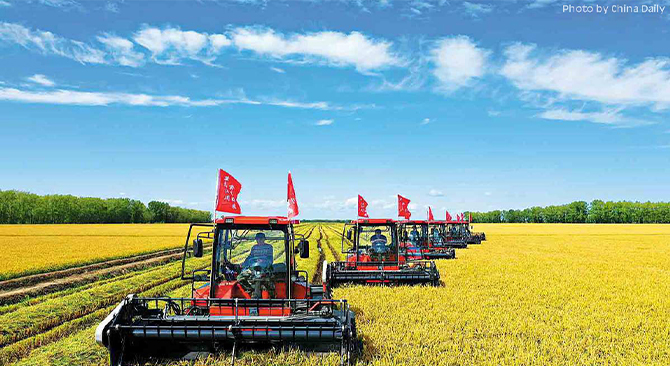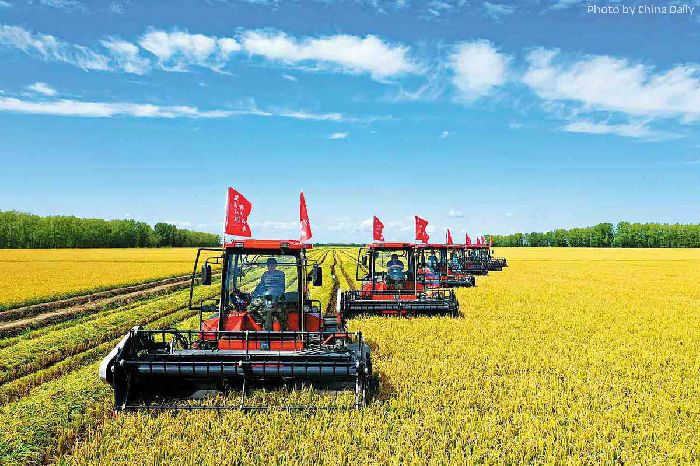



Combine harvesters are used to harvest rice on farmland belonging to the Beidahuang Agricultural Reclamation Group. [Photo/China Daily]
6. KEY TASKS
6.6 Strengthening and improving the rural management to build a civilized and harmonious village.
Prioritizing the guarantee and improvement of the rural people’s wellbeing, highlighting organizational leadership, social service, and democratic participation, accelerating the establishment of the rural governance model which combines self-governance, rule of law, and rule of virtue under the leadership of the Communist Party of China, and building a vital, harmonious, and orderly village with good governance.
Improving the rural governance system. To strengthen the construction of primary-level organizations. Establish a village-level organization system based on the self-governance and affair supervision represented by villager autonomy under the leadership of the primary-level Party, which is linked by the collective economic organizations, farmers' cooperative organizations, and other economic social organizations. Improve the villagers (representatives) meeting system and the village-level democratic consultation and decision-making mechanism, and expand the platform for villagers to participate in village-level public affairs.
To enhance the efficiency of rural governance. The counties’ governments should strictly delegate the power to the primary-level governments and integrate the similar functions and overlapping responsibilities of departments in both towns and counties. Improve the department coordination mechanism of towns and counties and ensure that the governments of towns should fulfill their responsibilities in comprehensive governance, security production, etc. Regulate the work of village-level organizations and improve the cooperation mechanism of rural governance affairs.
To further the progress in building peaceful villages. Strengthen the defense across society, deepen the digital management for a matrix of rural communities, promote the carefulness of rural primary-level management services, enhance the risk evaluation, monitoring, and early warning, and emergency response of severe incidents such as natural disasters, public health, and safety hazards in rural areas.
Improving the farmers’ understanding and appreciation of science and culture. To upgrade the rural education and training system. Establish a farmer education and training system and encourage lifelong learning for them. Channel high-quality education resources down to the villages to promote the co-construction, benefit-sharing, and optimization of education and training resources.
To cultivate a large number of outstanding farmers. Strengthen the training of high-caliber farmers, increase the cultivation of practical talents in rural areas, and implement training projects for agricultural entrepreneurs and start-up farmers. Deepen the reform of agricultural professional education and train a group of high-caliber rural talents.
Promoting rural cultural-ethical standards and other projects in the New Era. To raise ideological and ethical standards in rural areas. In-depth educate people about Xi Jinping Thought on Socialism with Chinese Characteristics for a New Era, carry out promotion and education on the history of the Party, the People’s Republic of China, reform and opening up, and the development of socialism, strengthen the guiding role of patriotism, collectivism, and socialism, promote and observe the core socialist values, implement initiatives to improve public etiquette and ethical standards.
To develop cultural programs and the cultural sector of villages. Implement the conservation and inheritance project of farming culture, strengthen the innovation of identification and transformation of agricultural culture heritage. Reinforce the protection and conservation of historic and cultural towns and villages, traditional villages, ethnic cunzhais, traditional vernacular dwellings, rural cultural relics, intangible heritage of culture contained in place names, and ancient and famous trees. Develop cultural industry with rural characteristics, improve the mechanism for supporting public cultural activities, and meet farmers' spiritual and cultural needs.
To continuously abandon outdated social mores in rural areas. Carry out special civilized actions, stress family values, family education, and family building, improve the rural credit system, speed up the popularization of science, and manage rural religious affairs in accordance with the law.
6.7 Achieving the effective connection between consolidating the results of poverty elimination and rural revitalization.
Vigorously advocate the spirit of poverty alleviation, effectively connect the consolidating achievements of poverty elimination with rural revitalization, and enhance the internal momentum for development in formerly impoverished areas, so that the people lifted out of poverty can live a better life and gradually march toward shared all-round prosperity.
Consolidating the achievements of poverty elimination. During the grace period, the people will continue to enjoy the main support policies. Strictly apply the poverty alleviation policies and government supervision and provide stable subsistence allowances, implement education, medical care, housing, and other inclusive public services ensuring basic living standards with equal access. Optimize the development policies such as industry and employment.
To improve the dynamic monitoring of any trends indicating a return to poverty and associated support measures. Regularly check on key groups, such as those who have just emerged from poverty but whose position is far from secure, those on the verge of poverty who can fall back in again easily, and those experiencing difficulties in meeting their basic needs due to expenditure induced by illness, disaster or accident, or due to a sharp drop in income, and exercise dynamic management to spot these trends early and establish a rapid detection and response mechanism. Adjust and optimize the main support policies by category, carry out regular verification and ensure they all have stayed out of poverty and have not fallen back in a timely manner.
To realize the “Two Assurances and Three Guarantees” (This refers to assurances of adequate food and clothing, and guarantees of access to compulsory education, basic medical services, and safe housing for impoverished rural residents.). Consolidate the achievement of poverty alleviation via education, improve the initiative to address school dropout rates and ensure attendance, and achieve clear reductions in rural student dropout rates in poor areas. Launch the health care and medical insurance for poverty alleviation to effectively prevent the risk of people returning into poverty because of falling ill. Steadily expand the coverage of rural medical and health services. Implement the subsidizing insurance policies by category and encourage people emerging from poverty to participate in the insurance plan. Establish a dynamic monitoring mechanism for housing safety of rural people emerging from poverty, and ensure the basic housing safety of low-income people.
To strengthen the follow-up support for the people relocated from inhospitable areas. Focus on the once deeply impoverished areas and large and medium-sized centralized resettlement areas, improve the follow-up support policies in terms of employment needs, industrial development, and subsequent supporting facilities, and continue to consolidate the achievements of poverty alleviation through relocation.
To improve the asset management of poverty alleviation projects. Conduct throughout investigations of the poverty alleviation projects’ assets and establish an asset management record according to the classification of operating assets, public welfare assets, and household assets. Clarify the responsibility for the asset management of property rights, introduce the beneficiaries to participate in the management, and explore diversified modes of asset operation and management.
Improving the overall development of poverty alleviation areas. To support and guide poor areas in developing sustainable economic activities geared to their special resources. Launch the upgrading actions of seed and breeding industries, improve the support policies for the whole industrial chain, and strengthen the construction of industrial development facilities.
To promote the stable employment of people emerging from poverty. Steadily expand the employment transfer of rural labor in poverty alleviation areas, carry out large-scale professional training, and increase the export of organized labor services.
To improve the development conditions of poverty alleviation areas. Expand the coverage of infrastructure in areas emerging from poverty and promote the overall improvement in the county. Continue to support the improvement and upgrade of the living environment as well as the infrastructure construction in these areas. And the public services should also be improved.
Improving the main support mechanism for helping rural low-income people and undeveloped areas. To improve the regular support mechanism for low-income people. Carry out dynamic monitoring of rural low-income people and improve the categorized support mechanism.
To focus on supporting key counties for rural revitalization. Coordinate and integrate resources from all participants, strengthen the input guarantee, and list the 160 designated key counties for rural revitalization in western regions as the priority objectives. Support localities to free select some poverty alleviation counties as key counties for advancing rural revitalization.
To support undeveloped regions to consolidate the achievements of poverty alleviation and rural revitalization. Increase the financial transfer payments to those regions and continuously improve the rural infrastructure and public services.
To deepen the collaboration on poverty alleviation between the eastern and western regions while promoting social support. Adhere to improve the collaboration mechanism between the eastern and western regions, strengthen industrial cooperation, enable better alignment in resources, labor and talent, support phased trans-regional relocation of industries, and encourage the joint construction of industrial parks between the eastern and western regions.
7. REFORM MEASURES
With the focus on the activating rural resources as well as factors and based on the respect of creation by grassroots and people, it is important to accelerate the reform of key sectors and processes in villages to promote the equal exchange of factors between urban and rural areas and encourage more factors to agglomerate in rural areas while enhancing the vitality of agricultural and rural development.
The reform measures can be summarized as the five aspects in terms of the exchange of urban and rural factors, rural property rights system, agriculture support system, collective property rights and other relative rights such as ownership rights, contracting rights, and management rights, and opening-up.
Source:
<http://www.moa.gov.cn/govpublic/FZJHS/202202/t20220211_6388494.html>
<http://english.www.gov.cn/policies/latestreleases/202202/11/content_WS620654d4c6d09c94e48a4f38.html>
Edited and translated by GUO Xinxin